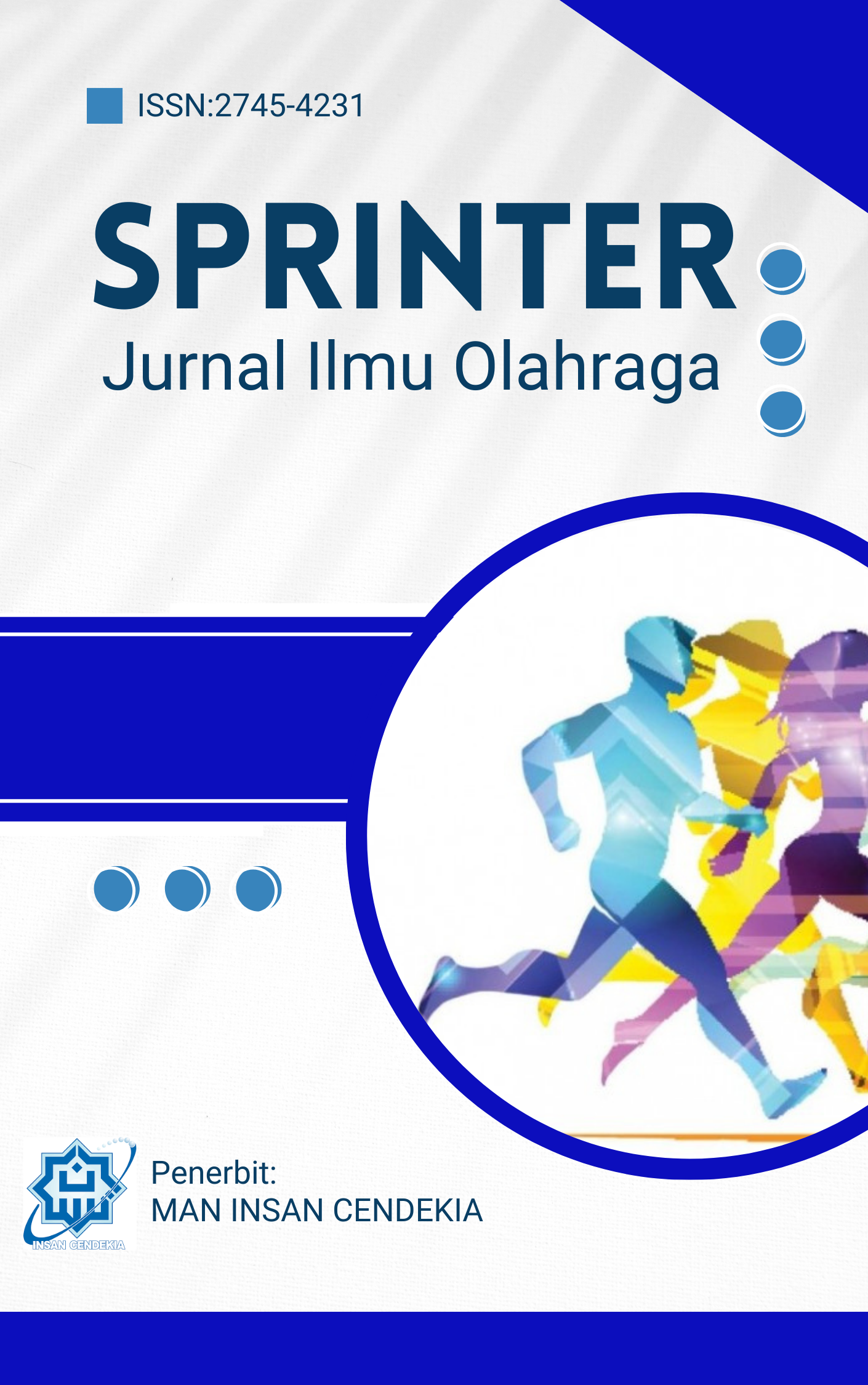Upaya Meningkatkan Teknik Dasar Pukulan Forehand Smash pada Permainan Tenis Meja melalui Latihan Shadow
DOI:
https://doi.org/10.46838/spr.v6i2.822Keywords:
Forehand; Physical Education; Shadow; Smash, Basic Technique; Table TennisAbstract
The purpose of this study was to determine the effect of shadow training on improving the basic technique of forehand smash in table tennis for tenth grade students of SMK NWDI Pancor. The forehand smash technique is an important component in table tennis that requires good movement coordination, proper body position, and accurate arm swing. However, initial observations showed that many students had difficulty in mastering this technique optimally. A quantitative approach was applied in this study, using a pre-experimental design as its main framework, a one-group pretest-posttest design. The research sample consisted of 25 students selected through a saturated sampling technique. The data collection instrument was a practical test with assessment aspects including body position, arm swing, shot accuracy, and coordination. The results of data analysis showed an increase in the average score from 46.6 in the pretest to 64.6 in the posttest. Hypothesis testing using the paired sample t-test method produced a significance value of 0.000 (p < 0.05), indicating that shadow training had a significant impact on improving the basic technique of forehand smash. Thus, shadow training has been proven effective in improving students' basic table tennis skills, especially in terms of forehand smash, and is recommended as an alternative learning method in physical education.
References
Archana, M., & Geetha, M. K. (2015). Object Detection and Tracking Based on Trajectory in Broadcast Tennis Video. Procedia Computer Science, 58, 225–232. https://doi.org/10.1016/j.procs.2015.08.060
Aviñó-Calero, J., Santateresa, E., Orden, L., Marks, E. A. N., Martínez Sabater, E., Andreu-Rodriguez, J., Saéz-Tovar, J. A., Pérez-Murcia, M. D., Bustamante, M. Á., & Moral, R. (2024). Optimization of industrial-scale composting of dewatered pig slurry and olive mill waste using discarded tennis balls as an inert bulking agent. Environmental Technology and Innovation, 36. https://doi.org/10.1016/j.eti.2024.103799
Carlhed Ydhag, C., & Osman, A. (2025). Configurations, dynamics, and temporality: Exploring the social networks of students and their relevance for successful transitions into higher education. International Journal of Educational Research Open, 8. https://doi.org/10.1016/j.ijedro.2024.100419
Crespo, M., Martinez-Gallego, R., & Nash, C. (2024). Reflections on 20 years of the international tennis federation and olympic solidarity high-performance coach education scholarship programme: Implications for sports coach development. Heliyon, 10(22). https://doi.org/10.1016/j.heliyon.2024.e40006
Deutscher, C., Neuberg, L., & Thiem, S. (2023). Who’s afraid of the GOATs? - Shadow effects of tennis superstars. Journal of Economic Psychology, 99. https://doi.org/10.1016/j.joep.2023.102663
Du, Y., Xia, Y., Wang, L., Zhang, T., & Ju, L. (2024). The influence of psychological change factors of tennis training strategy using optimized recurrent neural network and artificial intelligence. Heliyon, 10(13). https://doi.org/10.1016/j.heliyon.2024.e33273
Ersever, E. M., & Goktas, B. (2025). The effect of core exercises on shoulder rotator strength, core endurance and suprasipinatus structure in tennis players with rotator cuff injuries. Journal of Tissue Viability, 34(3). https://doi.org/10.1016/j.jtv.2025.100934
He, S. (2024). The application of deep learning-based technique detection model in table tennis teaching and learning. Systems and Soft Computing, 6. https://doi.org/10.1016/j.sasc.2024.200116
Javadiha, M., Andujar, C., Lacasa, E., Shirato, G., Andrienko, N., & Andrienko, G. (2025). Visualizing game dynamics at a specific time: Influence of the players’ poses for tactical analyses in padel. Visual Informatics, 100256. https://doi.org/10.1016/j.visinf.2025.100256
Kim, N. G., & Grocki, M. J. (2006). Multiple sources of information and time-to-contact judgments. Vision Research, 46(12), 1946–1958. https://doi.org/10.1016/j.visres.2005.12.011
Li, R., Ye, S., Bai, Z., Nedzved, A., & Tuzikov, A. (2024). Moderate Red-Edge vegetation index for High-Resolution multispectral remote sensing images in urban areas. Ecological Indicators, 167. https://doi.org/10.1016/j.ecolind.2024.112645
Li, Y., & Zhu, Y. (2022). Research on Key Technologies of Garbage Classification Virtual Simulation Game Development Based on unity3d Technology. Procedia Computer Science, 208, 546–552. https://doi.org/10.1016/j.procs.2022.10.075
Niu, Y., & Khishe, M. (2025). Autonomous sensor node system for table tennis officiating: Optimized placement using enhanced chimp optimization algorithm. Results in Engineering, 26. https://doi.org/10.1016/j.rineng.2025.105558
Picchio, M., & van Ours, J. C. (2024). The impact of high temperatures on performance in work-related activities. Labour Economics, 87. https://doi.org/10.1016/j.labeco.2024.102509
Tabrizi, S. S., Pashazadeh, S., & Javani, V. (2020). Data acquired by a single object sensor for the detection and quality evaluation of table tennis forehand strokes. Data in Brief, 33. https://doi.org/10.1016/j.dib.2020.106504
Wang, C.-Y., Lai, K. G., & Huang, H.-C. (2024). Specifications Table. Data in Brief, 55, 110665. https://doi.org/10.17632/nv3rpsxhhkt
Xin, Z. (2025). Diagnosis model for action problems of table tennis beginners based on improved DTW algorithm. Systems and Soft Computing, 7. https://doi.org/10.1016/j.sasc.2025.200350
Xu, J., Xu, W., & Sang, M. (2024). Study of the synergistic effect of analogical and explicit learning in beginning junior tennis players. Heliyon, 10(19). https://doi.org/10.1016/j.heliyon.2024.e38590
Yamaguchi, J., Funasaki, H., Kubota, D., Tanaka, K., Nagai, S., & Saito, M. (2025). Focal periphyseal edema of the knee in a junior youth tennis player: A case report. Radiology Case Reports, 20(7), 3588–3591. https://doi.org/10.1016/j.radcr.2025.04.020
Zhu, Y., Yu, W., & Li, R. (2025). SAGCN: A spatiotemporal attention-weighted graph convolutional network with IoT integration for adolescent tennis motion analysis. Alexandria Engineering Journal, 128, 652–662. https://doi.org/10.1016/j.aej.2025.05.069
Published
How to Cite
Issue
Section
Copyright (c) 2025 Mahfuz, Hariadi, Riskika Agus Tiawan, Zaenul Arkanuddin

This work is licensed under a Creative Commons Attribution-ShareAlike 4.0 International License.









